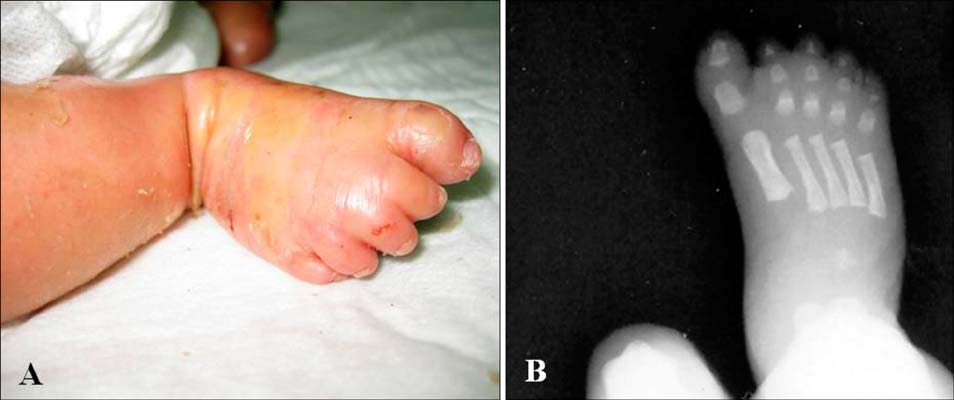Ann Dermatol.
2013 Nov;25(4):483-488. 10.5021/ad.2013.25.4.483.
A Collodion Baby with Facial Dysmorphism, Limb Anomalies, Pachygyria and Genital Hypoplasia: A Mild Form of Neu-Laxova Syndrome or a New Entity?
- Affiliations
-
- 1Department of Dermatology, Baskent University Faculty of Medicine, Ankara, Turkey. derenozcan@yahoo.com.tr
- 2Department of Pediatrics, Baskent University Faculty of Medicine, Ankara, Turkey.
- 3Department of Radiology, Baskent University Faculty of Medicine, Ankara, Turkey.
- 4Genetique Medicale et Developpement, Faculte de Medecine de la Timone, Marseille, France.
- KMID: 2265064
- DOI: http://doi.org/10.5021/ad.2013.25.4.483
Abstract
- Neu-Laxova syndrome is a rare, lethal, autosomal recessive disorder characterized by intrauterine growth retardation, central nervous system anomalies, skin findings, such as ichthyosis, edema, collodion baby and harlequin fetus, facial dysmorphic features, limb anomalies and genital hypoplasia. Although it is generally a lethal condition, cases of such patients who lived beyond 6 months and 10 months of age have been reported. Here, we describe an 8-year-old boy who was born with collodion membrane, facial dysmorphic features, limb anomalies, genital hypoplasia and pachygyria. He had no major health problems over the course of 8 years of follow-up, except for mild mental/motor retardation, ichthyosis, facial dysmorphic features and limb anomalies. Based on these features, we suggest that because Neu-Laxova syndrome represents a heterogeneous phenotype, our case may be a milder variant of this syndrome or a new genetic entity.
Keyword
MeSH Terms
Figure
Reference
-
1. Neu RL, Kajii T, Gardner LI, Nagyfy SF. A lethal syndrome of microcephaly with multiple congenital anomalies in three siblings. Pediatrics. 1971; 47:610–612.
Article2. Laxova R, Ohara PT, Timothy JA. A further example of a lethal autosomal recessive condition in sibs. J Ment Defic Res. 1972; 16:139–143.
Article3. Lazjuk GI, Lurie IW, Ostrowskaja TI, Cherstvoy ED, Kirillova IA, Nedzved MK, et al. Brief clinical observations: the Neu-Laxova syndrome--a distinct entity. Am J Med Genet. 1979; 3:261–267.4. Manning MA, Cunniff CM, Colby CE, El-Sayed YY, Hoyme HE. Neu-Laxova syndrome: detailed prenatal diagnostic and post-mortem findings and literature review. Am J Med Genet A. 2004; 125A:240–249.
Article5. Carder KR, Fitzpatrick JE, Weston WL. What syndrome is this? Neu-Laxova syndrome. Pediatr Dermatol. 2003; 20:78–80.6. Horn D, Müller D, Thiele H, Kunze J. Extreme microcephaly, severe growth and mental retardation, flexion contractures, and ichthyotic skin in two brothers: a new syndrome or mild form of Neu-Laxova syndrome? Clin Dysmorphol. 1997; 6:323–328.
Article7. Shved IA, Lazjuk GI, Cherstvoy ED. Elaboration of the phenotypic changes of the upper limbs in the Neu-Laxova syndrome. Am J Med Genet. 1985; 20:1–11.
Article8. Ejeckam GG, Wadhwa JK, Williams JP, Lacson AG. Neu-Laxova syndrome: report of two cases. Pediatr Pathol. 1986; 5:295–306.
Article9. Scott CI, Louro JM, Laurence KM, Tolarová M, Hall JG, Reed S, et al. Comments on the Neu-Laxova syndrome and CAD complex. Am J Med Genet. 1981; 9:165–175.
Article10. Kuseyri F, Bilge I, Bilgiç L, Apak MY. Neu-Laxova syndrome: report of a case from Turkey. Clin Genet. 1993; 43:267–269.
Article11. Shapiro I, Borochowitz Z, Degani S, Dar H, Ibschitz I, Sharf M. Neu-Laxova syndrome: prenatal ultrasonographic diagnosis, clinical and pathological studies, and new manifestations. Am J Med Genet. 1992; 43:602–605.
Article12. Kahyaoglu S, Turgay I, Ertas IE, Ceylaner S, Danisman N. Neu-Laxova syndrome, grossly appearing normal on 20 weeks ultrasonographic scan, that manifested late in pregnancy: a case report. Arch Gynecol Obstet. 2007; 276:367–370.
Article13. Dilli D, Yaşar H, Dilmen U, Ceylaner G. Neu-Laxova syndrome in an appropriate for gestational age newborn. Indian J Dermatol Venereol Leprol. 2008; 74:487–489.
Article14. Mihci E, Simsek M, Mendilcioglu I, Tacoy S, Karaveli S. Evaluation of a fetus with Neu-Laxova syndrome through prenatal, clinical, and pathological findings. Fetal Diagn Ther. 2005; 20:167–170.
Article15. Ugras M, Kocak G, Ozcan H. Neu-Laxova syndrome: a case report and review of the literature. J Eur Acad Dermatol Venereol. 2006; 20:1126–1128.
Article16. Aslan H, Gul A, Polat I, Mutaf C, Agar M, Ceylan Y. Prenatal diagnosis of Neu-Laxova syndrome: a case report. BMC Pregnancy Childbirth. 2002; 2:1.
Article17. Manar AL, Asma B. Neu-Laxova syndrome: a new patient with detailed antenatal and post-natal findings. Am J Med Genet A. 2010; 152A:3193–3196.
Article18. Coto-Puckett WL, Gilbert-Barness E, Steelman CK, Stuart T, Robinson HB, Shehata BM. A spectrum of phenotypical expression of Neu-Laxova syndrome: three case reports and a review of the literature. Fetal Pediatr Pathol. 2010; 29:108–119.
Article19. Thakur S, Pal L, Phadke SR. Lethal arthrogryposis with icthyosis: overlap with Neu-Laxova syndrome, restrictive dermopathy and harlequin fetus. Clin Dysmorphol. 2004; 13:117–119.
Article20. Moulson CL, Go G, Gardner JM, van der Wal AC, Smitt JH, van Hagen JM, et al. Homozygous and compound heterozygous mutations in ZMPSTE24 cause the laminopathy restrictive dermopathy. J Invest Dermatol. 2005; 125:913–919.
Article



